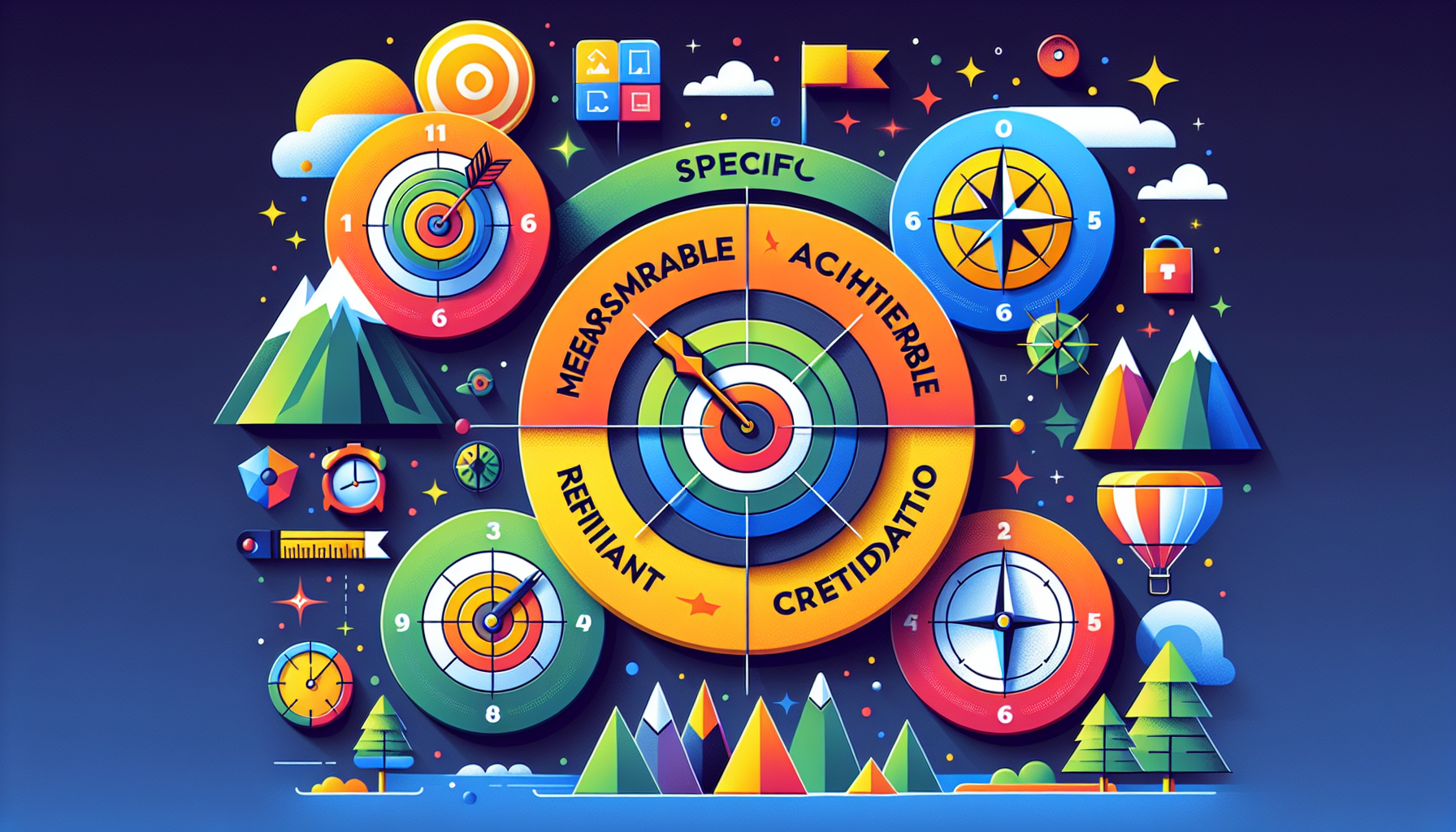Achieve your goals with a clear plan. This guide on how to set goals and achieve them will show you step-by-step methods to define, plan, and reach your goals. You’ll get practical tips to ensure success.
Key Takeaways
- Define your goals using the SMART framework: Specific, Measurable, Achievable, Relevant, and Time-bound to enhance clarity and effectiveness.
- Create a structured action plan by breaking down larger goals into manageable steps and incorporating regular check-ins to track progress.
- Stay flexible and adjust your goals as needed; celebrate small wins along the way to maintain motivation and momentum toward achieving your aspirations.
Understanding Goal Setting

Goal setting is the foundation of any successful endeavor. It provides a clear perspective on what’s important and creates meaning in life. Clearly defining what you want and understanding why sets you on a path to achieving those goals. This process isn’t just about jotting down a list of desires; it’s about creating a structured plan to turn those desires into reality.
In today’s fast-paced world, goal setting encourages you to consider significant milestones and determine the direction of your efforts. Think of it as a roadmap; without it, you might wander aimlessly, wasting time and resources.
Setting personal goals involves a thorough examination of lifetime aspirations and then breaking them down into manageable time frames, from five-year plans to daily tasks. Each step you take toward your goal leads to another until you finally achieve it. Effective strategies for goal setting are essential for success in both personal and professional life.
What is Goal Setting?
Goal setting is a purposeful process of identifying objectives and creating a plan to achieve them. A goal is something you desire to accomplish. It represents an achievement you aim for. This process is structured and involves identifying clear, measurable goals and creating actionable plans to reach them. Key steps in the goal-setting process start with careful consideration of what you desire, followed by hard work and defined steps to achieve those desires.
When setting achievable goals, it’s crucial to consider your capabilities and constraints, such as time, finances, resources, and capacity. Choose goals that inspire, motivate, and challenge you to achieve goals.
Establishing lifetime goals initially provides a strong foundation for setting more specific personal goals. This approach ensures that your goals are not only attainable but also aligned with your long-term aspirations.
Why is Goal Setting Important?
Goal setting is vital because it provides direction and motivation in both personal and professional life. Setting clear goals enhances your focus, provides a long-term vision, and increases self-confidence. It helps identify distractions, ensuring that your decisions and actions contribute to achieving these goals.
Setting goals allows you to orchestrate your resources and efforts, creating a sense of control over your future. This sense of control is empowering and can drive you to achieve more than you ever thought possible. In essence, goal setting helps align your actions with your ambitions, making goal setting theory a critical component of success.
Setting SMART Goals

The SMART goals framework is a powerful tool for designing goals that maximize their impact. SMART stands for Specific, Measurable, Achievable, Relevant, and Time-bound. This framework ensures that your goals are clear, actionable, and attainable, providing a structured approach to goal setting.
Nearly everyone, including students, teachers, entrepreneurs, and athletes, can benefit from SMART goal setting. Answering the six ‘W’s’ (who, what, when, where, why, and which) helps create specific goals that are easier to achieve. This method not only clarifies your objectives but also lays out a clear path to success.
Specific
Defining goals in a clear and precise manner is essential in goal setting. Specific goals enhance motivation by providing a clear target to aim for, resulting in a higher chance of completing the goal. For instance, a specific goal in a team setting could be to take on the role of captain in a soccer team. Another example could be related to customer satisfaction, such as having customers complete satisfaction rating surveys.
The SMART framework ensures that your career goals are clearly defined and actionable. One strategy for keeping your goals visible is to place written goals in locations you visit often, such as your workspace or home refrigerator, to remind yourself of your objectives. This constant reminder helps maintain focus and commitment.
Measurable
Measurement is a key aspect of effective goal setting. Having measurable goals allows you to track progress and stay motivated. Measurement provides feedback and insight into your progress towards reaching your goals. For example, tracking measurable goals allows individuals to see progress and adjust efforts accordingly.
When setting measurable goals, it’s essential to include precise amounts or dates in your goals. Ask yourself how you will know when the goal is accomplished and what steps are needed to reach it. Providing feedback, like giving team updates twice a month, can be a measurable aspect of the goal. This clarity helps you stay on track and make necessary adjustments along the way.
Achievable
Achievable goals encourage individuals to stretch their abilities without setting them up for failure. These attainable goals should be realistic yet challenging. Setting goals that are big enough to be inspiring but still realistic is crucial for maintaining motivation.
Personal goals should not depend on external factors or other people. When determining the realism of a goal, it’s important to analyze its relevance to other goals and personal fit. Setting an upper limit to goals helps sustain progress and encourages continuous engagement.
On the other hand, if goals are too easy, it may lead to an anticlimactic feeling and fear of future goals.
Relevant
Goals should resonate with an individual’s personal values to ensure commitment and alignment. When goals align with personal values, individuals are more likely to stay committed to achieving them. This alignment helps maintain focus on what truly matters, leading to greater satisfaction and achievement.
Having relevant goals that align with your values and long-term aspirations makes the goal-setting process more meaningful. It ensures that your efforts are directed towards something that genuinely matters to you, increasing the likelihood of success.
Time-bound
Each goal should have a target completion date to maintain progress. Goals must have a deadline to increase urgency and achievement. This sense of urgency helps you prioritize tasks and stay focused on your objectives. While setting a goal, it’s important to ask yourself about the timeline. Specifically, when do you aim to achieve this goal?
An example of a time-bound aspect of a goal could be: ‘In the next two months’. By setting deadlines, you create a finish line that drives you to complete the goal. This approach helps ensure that you stay on track and make consistent progress towards achieving your goals.
Creating an Action Plan

Creating a structured plan is essential for achieving goals. A well-organized action plan lays out the steps you need to take to reach your objectives. Tools like Lucidchart can help in creating an organized action plan by providing a visual representation of your goals and the steps needed to achieve them.
Starting with smaller, manageable goals can help build confidence and develop long-term habits. Developing self-discipline is crucial for managing goal-related tasks effectively. Daily review of your To-Do List can help keep you on track towards your goals. Using a computer-based diary is a recommended way to schedule regular reviews of your goals.
Write Down Your Goals
People who write their goals are more likely to achieve them. Writing down goals makes them tangible and increases the chances of accomplishment. When you write down your goals, they become real and tangible. This process also helps clarify why the goals are valuable and important.
Start each goal with ‘I will’ and use positive language. Taking time to brainstorm before writing down goals can enhance the process. Using actionable language is empowering and motivating. Utilizing apps and planners can enhance organization and tracking progress toward goals.
Break Goals into Smaller Steps
Creating a step-by-step plan is the best way to accomplish long-term goals. Breaking down larger goals into smaller goals makes them more achievable. This process is called breaking down into smaller, manageable goals.
To keep motivation alive when pursuing goals, break them into smaller tasks. Initial smaller goals might include reading books and gathering information. Answering the six ‘W’s’ can help identify steps and support needs when setting a goal. As you progress through your action plan, cross off completed steps to track progress.
Set Deadlines for Each Step
Setting deadlines is crucial to maintain momentum and avoid procrastination. Creating an action plan involves breaking down goals into smaller, manageable steps with specific deadlines allocated to each. Writing down your goals increases commitment and helps in allocating deadlines for each step.
Dividing larger goals into smaller tasks makes it easier to set realistic deadlines for each step. Regular check-ins allow you to assess your progress against the deadlines you set. Reflecting on making progress is important to see if you are on track and to make any necessary adjustments.
Revise goals if needed based on your progress and changing circumstances to ensure effective deadline management.
Staying Motivated and Overcoming Challenges

Goal setting plays a vital role in enhancing focus and promoting self-mastery. SMART goals provide clarity and focus, helping individuals to be more productive and motivated. Accountability is essential for goal setting. It ensures steady progress and encourages continual effort toward achieving your objectives.
Regular evaluation of goals is necessary to measure progress, maintain motivation, and adjust accordingly. If you identify blockers in your goal-setting process, it’s important to make a plan or adjust your strategy as needed.
If you fail to meet your goals, learn from the experience to improve future efforts. Prevent burnout while pursuing goals by living a balanced life and taking breaks.
Keep Your Goals Visible
Using visual reminders of your goals can help to maintain focus and prompt action. Keeping your goals visible is essential for staying focused and committed to them. Consider placing your goals in visible locations such as your workspace, home refrigerator, or phone wallpaper.
Keeping your goals visible reinforces your commitment to achieving them, ultimately leading to greater success. This constant reminder ensures that your goals remain at the forefront of your mind, driving you to take consistent action towards achieving them.
Identify Potential Obstacles
Recognizing potential challenges in advance can make them seem more manageable. Recognizing that challenges are a normal part of the process can make them seem less daunting. Make a note of possible challenges you may encounter when pursuing your goals.
A negative environment can hinder your ability to stick to positive habits, making it crucial to prepare accordingly. Anticipating these obstacles allows you to develop strategies to overcome them and stay on track towards achieving your goals.
Celebrate Small Wins
Acknowledging small achievements plays a significant role in maintaining motivation and morale. Completing a challenging goal provides a sense of pride and builds confidence. Celebrating small wins involves recognizing and acknowledging minor achievements throughout the goal-setting process.
Recognizing these accomplishments helps boost overall motivation and encourages continued progress towards larger goals. This practice not only reinforces your commitment to your goals but also makes the journey towards achieving them more enjoyable.
Regularly Reviewing and Adjusting Goals
Consistent assessment of goals enhances the ability to measure effectiveness and adapt to changes. Regularly review and update your goals to maintain progress. If your goals were unrealistic, adjust your goals or tweak your plan.
Review your goals and consider adjustments if you haven’t achieved them on time. Adjust your long-term plans to align with shifting priorities. Also, incorporate your experiences into those modifications. Make necessary adjustments and keep going if you’re behind schedule on your goals. Consider updating your goals after significant changes in role expectations.
Schedule Regular Check-Ins
Setting aside time regularly to review goals can significantly enhance your focus and motivation. Setting periodic review sessions helps maintain focus and accountability towards goal achievement. Regular assessments not only provide a check on progress but also reinforce the commitment to your goals.
Incorporate scheduled check-ins into your routine to ensure you stay aligned with your objectives and make necessary adjustments. These regular reviews help you stay on track and make timely modifications to your action plan as needed.
Reflect on Progress
Measuring our goals provides insight into progress and evidence of improvement. Analyzing what strategies are effective aids in refining future actions and enhancing outcomes. Reflecting on progress helps to understand what actions are effective towards achieving goals.
Adjusting plans based on reflections allows for more effective goal pursuit and increases the likelihood of success. This reflective practice not only helps in tracking progress but also in identifying areas for improvement and making necessary adjustments to stay on course.
Revise Goals if Needed
Flexibility in adjusting goals ensures that they remain relevant and aligned with current circumstances. If you find that your goals are no longer realistic or aligned with your priorities, don’t hesitate to revise them. This flexibility allows you to stay motivated and focused on what truly matters.
Revising your goals as needed ensures that they remain meaningful and achievable. This process helps you stay aligned with your long-term aspirations and adapt to any changes in your life or work environment.
Practical Examples of Goal Setting

Various types of goals can be set, including career, personal, and health-related goals. Identifying the types of goals is crucial for effective goal-setting as it ensures alignment with personal values and priorities.
Practical examples of goal setting can provide valuable insights into how to apply these principles in real life. By understanding different types of goals, you can tailor your goal-setting process to suit your specific needs and aspirations.
Career Goals
Linking employee goals to company-wide goals motivates employees by showing their contribution to the bigger picture. When setting personal career goals, important considerations include income, independence, and hours committed.
An example of a career goal could be to be considered for the team captain of a college soccer team. To achieve the leadership goal of being team captain and to align with team goals, one might join a leadership honor society, attend every practice, and lead by example.
These strategies not only help in achieving career goals but also in developing leadership skills and professional growth.
Personal Goals
Personal goals are essential for personal development and overall well-being. Setting personal goals helps you focus on what truly matters to you and align your actions with your values and aspirations.
Three personal goal-setting tips can significantly help individuals focus and succeed in their personal development efforts. By setting specific, measurable, and achievable personal goals, you can make consistent progress towards a more fulfilling life.
Health Goals
Setting a health-related goal, such as losing weight, should be specific and clearly defined. An example could be setting a goal to lose 10 pounds in three months through a healthier diet and exercise. Creating an action plan involves breaking down the overall goal into smaller, manageable steps such as daily exercise and meal planning.
For instance, you might decide to exercise for 30 minutes five times a week and track your food intake to lose weight. Maintaining motivation can be achieved by regularly reviewing your progress and celebrating small wins along the way. This approach ensures that you stay on track and make steady progress towards your health goals.
Tips for Successful Goal Setting
Effective goal setting involves understanding broad guidelines and principles that enhance clarity and direction. Many individuals face challenges with goal-setting, often falling into the trap of setting the same resolutions yearly without follow-through. Framing goals positively can enhance motivation and focus, making it easier to commit to achieving them.
Setting challenging goals can lead to higher performance and motivation, while overly easy goals may result in minimal effort. Utilizing support structures such as leadership programs can provide inspiration, accountability, and resource assistance for achieving goals.
Concrete illustrations of various goal types can enhance understanding and application of the goal-setting process.
Stay Flexible
Flexibility allows individuals to adapt their goals as circumstances change, reducing feelings of overwhelm. Staying flexible allows you to adjust your goals to remain relevant and achievable, ensuring continuous progress. This adaptability helps maintain motivation and focus, allowing you to navigate any challenges that arise along the way.
Staying flexible ensures that you can make the necessary adjustments to stay on track and achieve your goals.
Seek Support
Involving supportive individuals in your goal journey can provide motivation and encouragement during challenging times. Having a support system is crucial for accountability and success in achieving your goals.
Support from friends, family, or mentors can be vital to sustain commitment and overcome obstacles. Seeking support helps you stay motivated and focused on your goals, increasing your chances of success.
Use Tools and Resources
Measuring your goals is essential as it allows you to celebrate achievements and maintain motivation. Using tools and resources can significantly enhance the goal-setting process by providing structure and organization.
Consider leveraging goal-setting apps or planners to keep your objectives organized and track your progress effectively. Staying organized with these tools ultimately leads to better focus and increased chances of achieving your goals.
Summary
In summary, goal setting is a powerful tool that provides direction, motivation, and a sense of control over your future. By understanding the principles of goal setting, utilizing the SMART framework, creating actionable plans, staying motivated, regularly reviewing and adjusting goals, and seeking support, you can achieve your personal and professional aspirations.
Start setting your goals today and take the first step towards a more fulfilling and purposeful life. Remember, the journey of a thousand miles begins with a single step. Set your goals, create a plan, and take action. You have the power to achieve anything you set your mind to.






